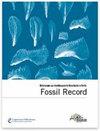下载PDF
{"title":"失sorophili temnospondyls的特征、分布和系统发育","authors":"Rainer R. Schoch","doi":"10.1002/mmng.201200010","DOIUrl":null,"url":null,"abstract":"<p>The phylogeny of the largely Permian temnospondyl group Dissorophidae is analyzed for the first time. Although hampered by poor preservation and incompleteness of finds, new data add substantially to our knowledge of the group. An analysis of 25 taxa and 70 characters gave the following results. (1) The Dissorophidae and Trematopidae each form monophyletic groups that are more closely related to one another than either of them is to amphibamids. Olsoniformes and Amphibamidae are each defined by clear-cut autapomorphies, making it unlikely that amphibamids are dwarfed dissorophids or olsoniforms. (2) <i>Ecolsonia</i> nests with <i>Fedexia</i> at the base of the Trematopidae. (3) The Dissorophidae falls into two major clades, the Dissorophinae sensu stricto (<i>Dissorophus</i>, <i>Broiliellus</i>) and the Cacopinae (<i>Cacops</i>, <i>Kamacops</i>, <i>Zygosaurus</i>). The Cacopinae is much better supported than the Dissorophinae. <i>Platyhystrix</i> and <i>Aspidosaurus</i> form successive sister taxa of all other dissorophids. Incompletely known dissorophids were found to nest as follows: (a) <i>Brevidorsum</i>, the Admiral Taxon and Rio Arriba Taxon at the base of the Cacopinae and (b) <i>Conjunctio multidens</i> forms an unresolved trichotomy with dissorophines and cacopines. The significance of osteoderms in dissorophid phylogeny is found to be much smaller than hitherto considered. (© 2012 WILEY-VCH Verlag GmbH & Co. KGaA, Weinheim)</p>","PeriodicalId":55147,"journal":{"name":"Fossil Record","volume":"15 2","pages":"121-137"},"PeriodicalIF":1.4000,"publicationDate":"2012-08-03","publicationTypes":"Journal Article","fieldsOfStudy":null,"isOpenAccess":false,"openAccessPdf":"https://sci-hub-pdf.com/10.1002/mmng.201200010","citationCount":"32","resultStr":"{\"title\":\"Character distribution and phylogeny of the dissorophid temnospondyls\",\"authors\":\"Rainer R. Schoch\",\"doi\":\"10.1002/mmng.201200010\",\"DOIUrl\":null,\"url\":null,\"abstract\":\"<p>The phylogeny of the largely Permian temnospondyl group Dissorophidae is analyzed for the first time. Although hampered by poor preservation and incompleteness of finds, new data add substantially to our knowledge of the group. An analysis of 25 taxa and 70 characters gave the following results. (1) The Dissorophidae and Trematopidae each form monophyletic groups that are more closely related to one another than either of them is to amphibamids. Olsoniformes and Amphibamidae are each defined by clear-cut autapomorphies, making it unlikely that amphibamids are dwarfed dissorophids or olsoniforms. (2) <i>Ecolsonia</i> nests with <i>Fedexia</i> at the base of the Trematopidae. (3) The Dissorophidae falls into two major clades, the Dissorophinae sensu stricto (<i>Dissorophus</i>, <i>Broiliellus</i>) and the Cacopinae (<i>Cacops</i>, <i>Kamacops</i>, <i>Zygosaurus</i>). The Cacopinae is much better supported than the Dissorophinae. <i>Platyhystrix</i> and <i>Aspidosaurus</i> form successive sister taxa of all other dissorophids. Incompletely known dissorophids were found to nest as follows: (a) <i>Brevidorsum</i>, the Admiral Taxon and Rio Arriba Taxon at the base of the Cacopinae and (b) <i>Conjunctio multidens</i> forms an unresolved trichotomy with dissorophines and cacopines. The significance of osteoderms in dissorophid phylogeny is found to be much smaller than hitherto considered. (© 2012 WILEY-VCH Verlag GmbH & Co. KGaA, Weinheim)</p>\",\"PeriodicalId\":55147,\"journal\":{\"name\":\"Fossil Record\",\"volume\":\"15 2\",\"pages\":\"121-137\"},\"PeriodicalIF\":1.4000,\"publicationDate\":\"2012-08-03\",\"publicationTypes\":\"Journal Article\",\"fieldsOfStudy\":null,\"isOpenAccess\":false,\"openAccessPdf\":\"https://sci-hub-pdf.com/10.1002/mmng.201200010\",\"citationCount\":\"32\",\"resultStr\":null,\"platform\":\"Semanticscholar\",\"paperid\":null,\"PeriodicalName\":\"Fossil Record\",\"FirstCategoryId\":\"89\",\"ListUrlMain\":\"https://onlinelibrary.wiley.com/doi/10.1002/mmng.201200010\",\"RegionNum\":4,\"RegionCategory\":\"地球科学\",\"ArticlePicture\":[],\"TitleCN\":null,\"AbstractTextCN\":null,\"PMCID\":null,\"EPubDate\":\"\",\"PubModel\":\"\",\"JCR\":\"Q3\",\"JCRName\":\"Earth and Planetary Sciences\",\"Score\":null,\"Total\":0}","platform":"Semanticscholar","paperid":null,"PeriodicalName":"Fossil Record","FirstCategoryId":"89","ListUrlMain":"https://onlinelibrary.wiley.com/doi/10.1002/mmng.201200010","RegionNum":4,"RegionCategory":"地球科学","ArticlePicture":[],"TitleCN":null,"AbstractTextCN":null,"PMCID":null,"EPubDate":"","PubModel":"","JCR":"Q3","JCRName":"Earth and Planetary Sciences","Score":null,"Total":0}
引用次数: 32
引用
批量引用


